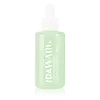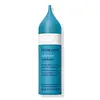What's inside
What's inside
 Key Ingredients
Key Ingredients

 Benefits
Benefits

 Concerns
Concerns

 Ingredients Side-by-side
Ingredients Side-by-side

Water
Skin ConditioningGlycerin
HumectantAloe Barbadensis Leaf Extract
EmollientPiroctone Olamine
PreservativeXanthan Gum
EmulsifyingCitric Acid
BufferingSodium Benzoate
MaskingAcetyl Tetrapeptide-3
Skin ProtectingDextran
Trifolium Pratense Flower Extract
AstringentSodium PCA
HumectantPotassium Sorbate
PreservativeTris(Tetramethylhydroxypiperidinol)Citrate
StabilisingLactic Acid
BufferingEthylhexylglycerin
Skin ConditioningButylene Glycol
HumectantAlcohol
AntimicrobialSodium Benzotriazolyl Butylphenol Sulfonate
UV AbsorberPhenoxyethanol
PreservativeParfum
MaskingWater, Glycerin, Aloe Barbadensis Leaf Extract, Piroctone Olamine, Xanthan Gum, Citric Acid, Sodium Benzoate, Acetyl Tetrapeptide-3, Dextran, Trifolium Pratense Flower Extract, Sodium PCA, Potassium Sorbate, Tris(Tetramethylhydroxypiperidinol)Citrate, Lactic Acid, Ethylhexylglycerin, Butylene Glycol, Alcohol, Sodium Benzotriazolyl Butylphenol Sulfonate, Phenoxyethanol, Parfum
Water
Skin ConditioningPropanediol
SolventMandelic Acid
AntimicrobialGlycolic Acid
BufferingGluconolactone
Skin ConditioningIsopentyldiol
HumectantPPG-24-Glycereth-24
EmulsifyingSaccharide Isomerate
HumectantMethyl Diisopropyl Propionamide
MaskingGaultheria Procumbens Leaf Extract
PerfumingAgave Tequilana Leaf Extract
AstringentBeta Vulgaris Root Extract
Skin ConditioningPentylene Glycol
Skin ConditioningPPG-26-Buteth-26
Skin ConditioningBetaine
HumectantGluconic Acid
Lysolecithin
EmulsifyingSclerotium Gum
Emulsion StabilisingCitric Acid
BufferingPullulan
Cellulose Gum
Emulsion StabilisingXanthan Gum
EmulsifyingHydroxyacetophenone
AntioxidantPEG-40 Hydrogenated Castor Oil
EmulsifyingSodium Citrate
BufferingSodium Benzoate
MaskingSodium Hydroxide
BufferingParfum
MaskingLimonene
PerfumingWater, Propanediol, Mandelic Acid, Glycolic Acid, Gluconolactone, Isopentyldiol, PPG-24-Glycereth-24, Saccharide Isomerate, Methyl Diisopropyl Propionamide, Gaultheria Procumbens Leaf Extract, Agave Tequilana Leaf Extract, Beta Vulgaris Root Extract, Pentylene Glycol, PPG-26-Buteth-26, Betaine, Gluconic Acid, Lysolecithin, Sclerotium Gum, Citric Acid, Pullulan, Cellulose Gum, Xanthan Gum, Hydroxyacetophenone, PEG-40 Hydrogenated Castor Oil, Sodium Citrate, Sodium Benzoate, Sodium Hydroxide, Parfum, Limonene
 Reviews
Reviews

Alternatives
Ingredients Explained
These ingredients are found in both products.
Ingredients higher up in an ingredient list are typically present in a larger amount.
Citric Acid is an alpha hydroxy acid (AHA) naturally found in citrus fruits like oranges, lemons, and limes.
Like other AHAs, citric acid can exfoliate skin by breaking down the bonds that hold dead skin cells together. This helps reveal smoother and brighter skin underneath.
However, this exfoliating effect only happens at high concentrations (20%) which can be hard to find in cosmetic products.
Due to this, citric acid is usually included in small amounts as a pH adjuster. This helps keep products slightly more acidic and compatible with skin's natural pH.
In skincare formulas, citric acid can:
While it can provide some skin benefits, research shows lactic acid and glycolic acid are generally more effective and less irritating exfoliants.
Most citric acid used in skincare today is made by fermenting sugars (usually from molasses). This synthetic version is identical to the natural citrus form but easier to stabilize and use in formulations.
Read more about some other popular AHA's here:
Learn more about Citric AcidParfum is a catch-all term for an ingredient or more that is used to give a scent to products.
Also called "fragrance", this ingredient can be a blend of hundreds of chemicals or plant oils. This means every product with "fragrance" or "parfum" in the ingredients list is a different mixture.
For instance, Habanolide is a proprietary trade name for a specific aroma chemical. When used as a fragrance ingredient in cosmetics, most aroma chemicals fall under the broad labeling category of “FRAGRANCE” or “PARFUM” according to EU and US regulations.
The term 'parfum' or 'fragrance' is not regulated in many countries. In many cases, it is up to the brand to define this term.
For instance, many brands choose to label themselves as "fragrance-free" because they are not using synthetic fragrances. However, their products may still contain ingredients such as essential oils that are considered a fragrance by INCI standards.
One example is Calendula flower extract. Calendula is an essential oil that still imparts a scent or 'fragrance'.
Depending on the blend, the ingredients in the mixture can cause allergies and sensitivities on the skin. Some ingredients that are known EU allergens include linalool and citronellol.
Parfum can also be used to mask or cover an unpleasant scent.
The bottom line is: not all fragrances/parfum/ingredients are created equally. If you are worried about fragrances, we recommend taking a closer look at an ingredient. And of course, we always recommend speaking with a professional.
Learn more about ParfumSodium Benzoate is a preservative. It's used in both cosmetic and food products to inhibit the growth of mold and bacteria. It is typically produced synthetically.
Both the US FDA and EU Health Committee have approved the use of sodium benzoate. In the US, levels of 0.1% (of the total product) are allowed.
Sodium benzoate works as a preservative by inhibiting the growth of bacteria inside of cells. It prevents the cell from fermenting a type of sugar using an enzyme called phosphofructokinase.
It is the salt of benzoic acid. Foods containing sodium benzoate include soda, salad dressings, condiments, fruit juices, wines, and snack foods.
Studies for using ascorbic acid and sodium benzoate in cosmetics are lacking, especially in skincare routines with multiple steps.
We always recommend speaking with a professional, such as a dermatologist, if you have any concerns.
Learn more about Sodium BenzoateWater. It's the most common cosmetic ingredient of all. You'll usually see it at the top of ingredient lists, meaning that it makes up the largest part of the product.
So why is it so popular? Water most often acts as a solvent - this means that it helps dissolve other ingredients into the formulation.
You'll also recognize water as that liquid we all need to stay alive. If you see this, drink a glass of water. Stay hydrated!
Learn more about WaterXanthan gum is used as a stabilizer and thickener within cosmetic products. It helps give products a sticky, thick feeling - preventing them from being too runny.
On the technical side of things, xanthan gum is a polysaccharide - a combination consisting of multiple sugar molecules bonded together.
Xanthan gum is a pretty common and great ingredient. It is a natural, non-toxic, non-irritating ingredient that is also commonly used in food products.
Learn more about Xanthan Gum